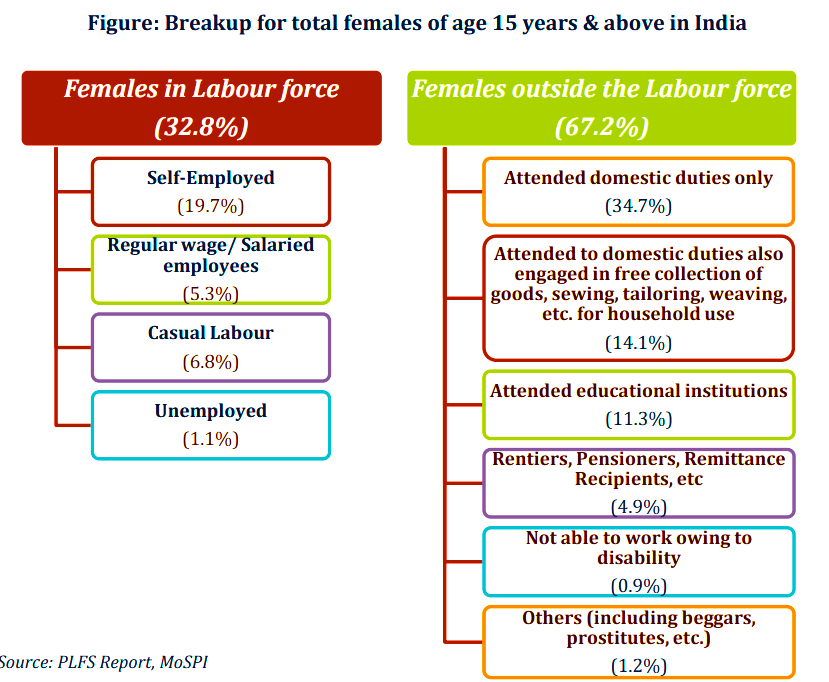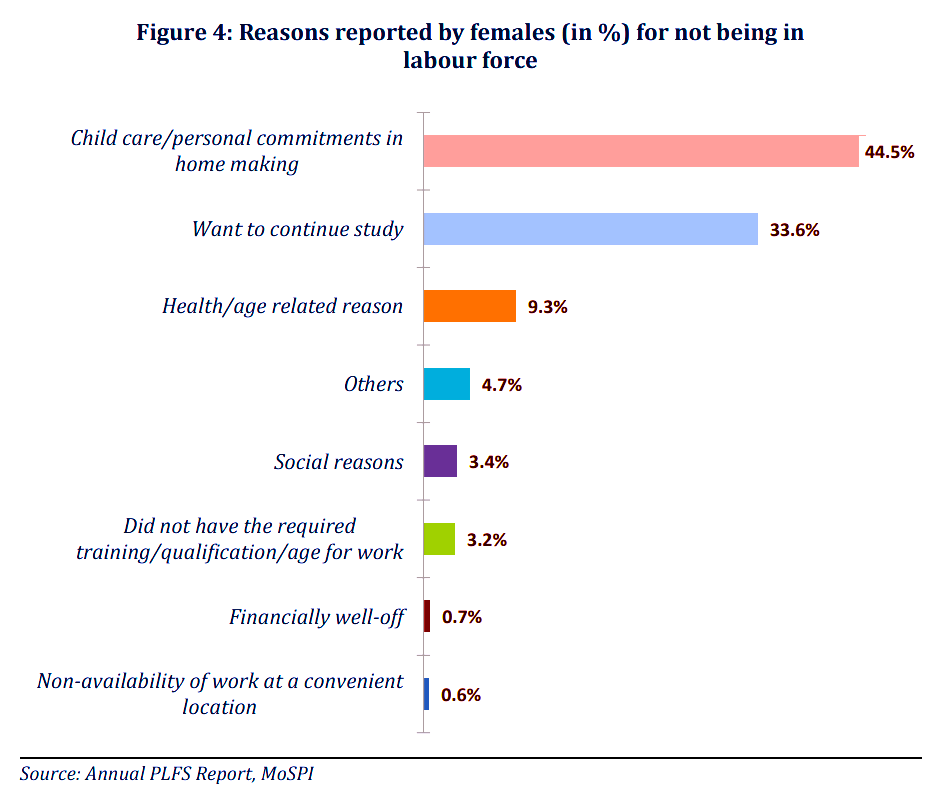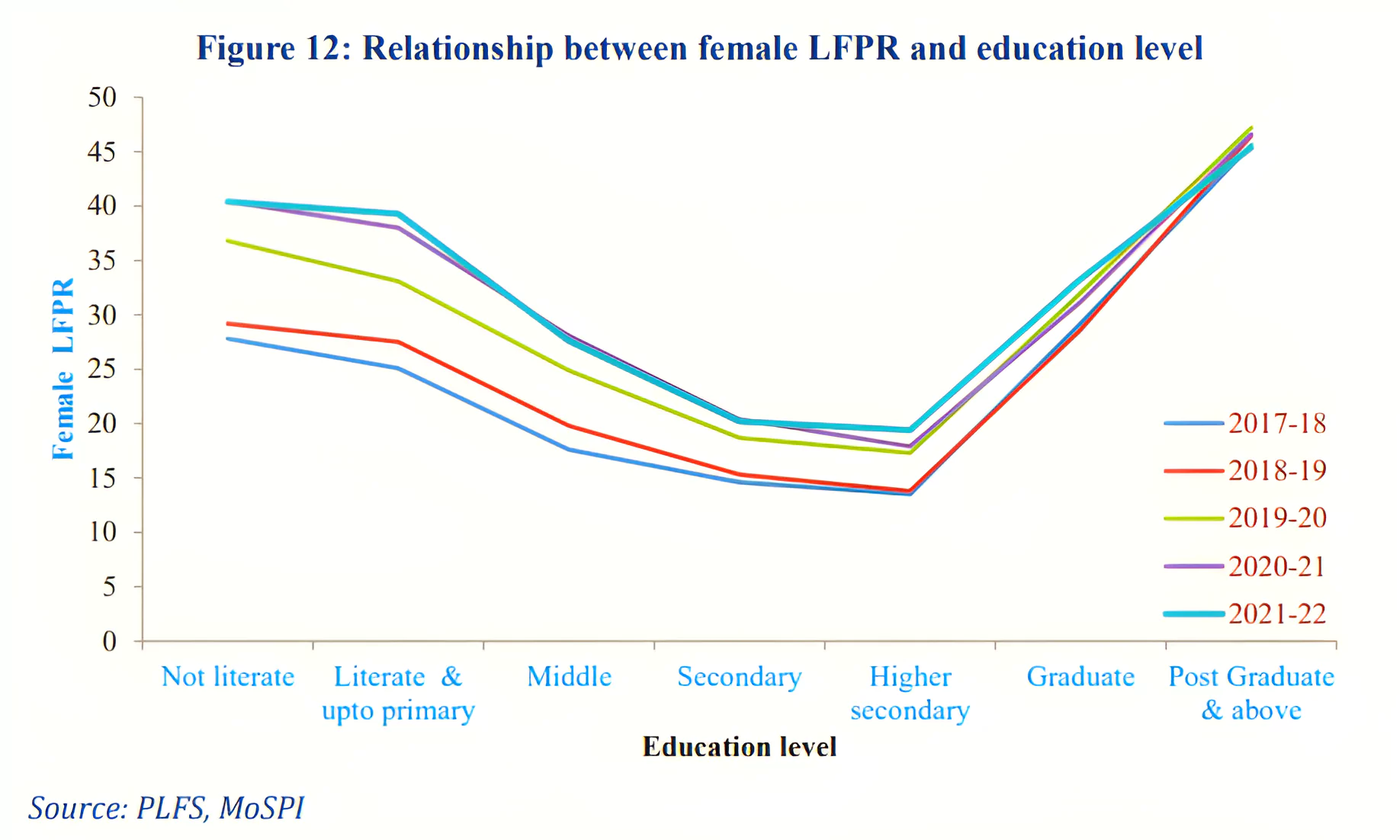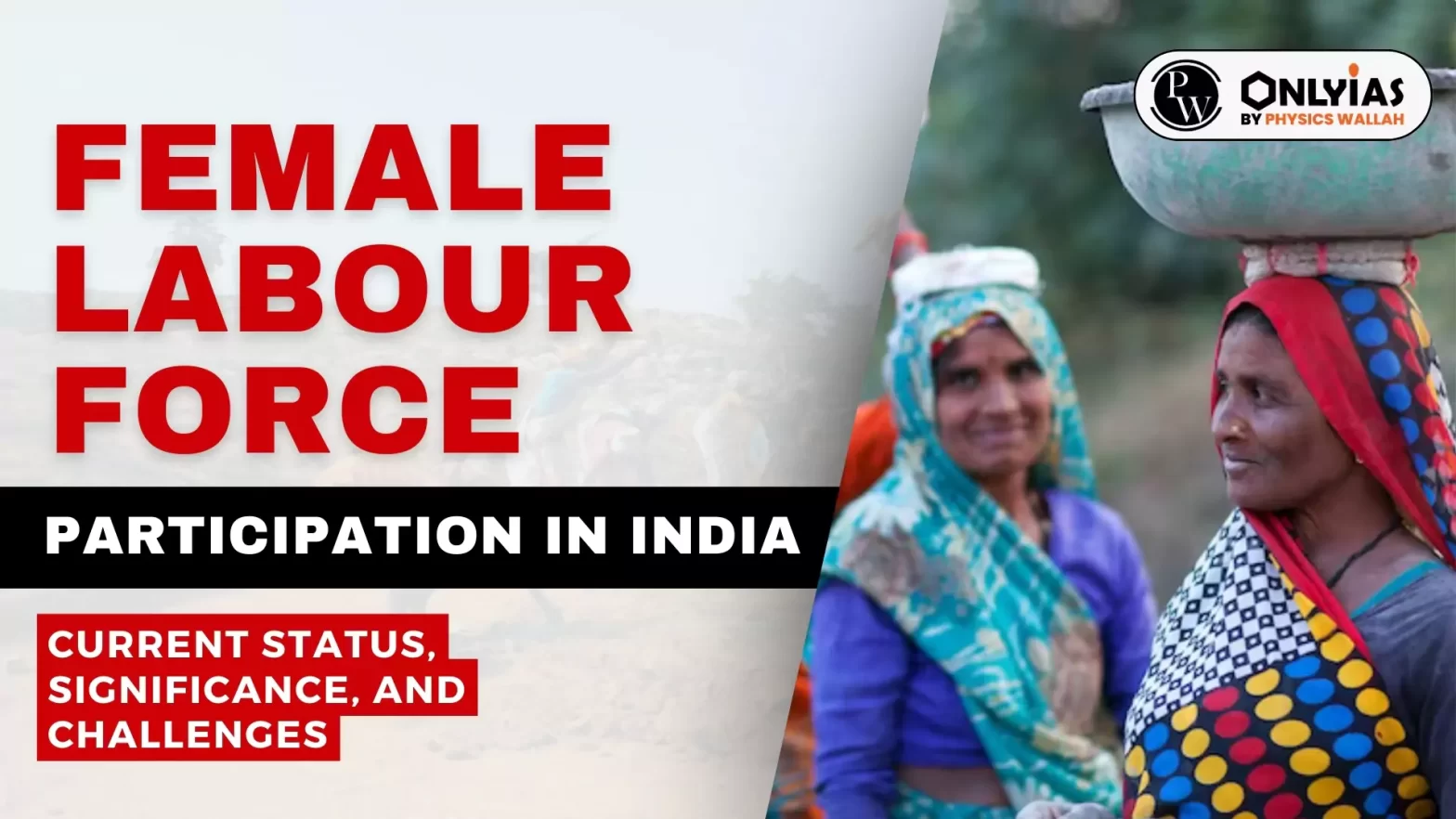Context:
This article is based on the news “Intersectionality of gender and caste in women’s participation in the labour force” which was published in the Hindu. According to Periodic Labour Force Survey (PLFS) 2021-22, Female Labour Force Participation Rate (LFPR) in India has been significantly increasing over the years and around 1/3rd of women have joined the labour force.
About Female Labour Force Participation
- Periodic Labour Force Survey (PLFS): The data on employment and unemployment is collected through PLFS which is conducted by the Ministry of Statistics & Programme Implementation (MoSPI) from 2017-18.
 Labour Force Participation Rate (LFPR): Labour Force Participation Rate is defined as the percentage of persons in labour force (i.e. working or seeking or available for work)in the population.
Labour Force Participation Rate (LFPR): Labour Force Participation Rate is defined as the percentage of persons in labour force (i.e. working or seeking or available for work)in the population.- Female Labour Force Participation Rate: As per the latest PLFS report, around 32.8% females of working age (15 years and above) were in the labour force in 2021-22 which was just 23.3% in 2017-18, registering a surge of 9.5% points during these years.
- Female Labour Force Participation Rate in Rural Sector: The major push came from the rural sector than the urban sector, where it increased by 12.0 percentage points.
- In rural areas, female Labour Force Participation Rate has increased to 36.6% during 2021-22 as compared to 24.6% in 2017-18.
- Female Labour Force Participation Rate in Urban Sector: Female Labour Force Participation Rate was 23.8% in 2021-22 as compared to 20.4% in 2017-18 in urban areas, showed an increase of just 3.4% points.
Female Labour Force Participation in India: Current Status
- Long-Term Decline in Female Labour Force Participation Rate: Over the past two decades, there has been a decline in female labour force participation (LFP), in line with an overall reduction in labour force engagement.
- The estimations indicate that female labour force participation in India between 1990 and 2022 has decreased from 28% to 24%.
- Short Term Rise in Female Labour Force Participation Rate: The latest Report of Periodic Labour Force Survey (PLFS) 2021-22 is evident of increased Female Labour Force Participation Rate (LFPR) in India.
- The estimated Labour Force Participation Rate on usual status for women of age 15 years and above in the country was 30.0% during 2019-20 which rose to 32.8% in 2021-22.
Factors Responsible for Low Female Labour Force Participation in India
- Society and Social Norms: Social norms are informal, unwritten rules of behaviour and social conduct that determines the acceptable, appropriate doings and attitudes in the given social context. The prevalent social norms for female are “Female Homemaker norm”, and for males are “Male Breadwinner norm”.
 Around 3.4% women were outside the labour force due to social reasons and most of the work of women is home based such as caregiving.
Around 3.4% women were outside the labour force due to social reasons and most of the work of women is home based such as caregiving.
- Unpaid Care Work: The prime social and cultural norm is ‘time poverty’ among married women. Females busy in their domestic activities are not paid for the labour they perform.
- Around 49% females are engaged in performing their domestic duties, child care, free collection of goods, sewing, tailoring, weaving, etc. for household use.
- Gender Biased Social Norms: In terms of gender, there are many barriers that women face ranging from societal expectations to legal and economic constraints in their pursuit of employment.
- For instance, there are laws in many companies that prevent women from working on the night shift.
- For instance, according to UNDP report, around 92.39 per cent of people in India justify intimate partner violence (physical or emotional abuse) in some way or believe that women should not have reproductive rights.
- Caste Discrimination: In the case of lower-caste households, there is higher female LFP in the informal sector, which is explained through economic constraints and limitations in social mobility.
- For instance, historically, people from the lower castes have been expected to engage in manual and domestic work irrespective of their gender, leading to their higher participation in the informal sector.
- Salary/Wage Disparity: Statistics suggest a significant pay disparity exists between males and females who are engaged in similar kinds of jobs with men earning more than women across all forms of work.
 In 2023, male self-employed workers earned 2.8 times that of women. In contrast, male regular wage workers earned 24% more than women and male casual workers earned 48% more than women.
In 2023, male self-employed workers earned 2.8 times that of women. In contrast, male regular wage workers earned 24% more than women and male casual workers earned 48% more than women.
- Education Levels: Many scholars have discussed the importance of education for women to access employment and women from higher castes (due to their economic condition) that have historically had a higher chance to access education, translating into better employment.
- Greater educational attainment leads to higher participation in the labour force and also increased productivity.
- According to the World Economic Forum, globally around 64 million women lost their jobs during the pandemic (twice as many as men), because women are more likely to work in informal, temporary, and part-time jobs.
Significance of Increasing Female Labour Force Participation in India
- Economic Growth: A higher Labour Force Participation Rate means more women are actively contributing to the workforce, which can lead to increased productivity and economic growth. Women bring diverse skills and perspectives to the workplace, fostering innovation and efficiency.
- For instance, a report by McKinsey Global Institute has estimated that just by offering equal opportunities to women, India could add US$ 770 billion to its GDP by 2025.
- Women’s Empowerment: Increased Labour Force Participation Rate means more women gain financial independence, allowing them to make decisions about their lives, education, and family.
- Further, participation in the workforce enhances women’s status in society, challenging traditional gender roles and fostering empowerment.
- Global Recognition: A diverse and inclusive workforce enhances a country’s global competitiveness by tapping into the full potential of its population. For instance, increasing female Labour Force Participation Rate imply improving SDG 5 (gender equality), SDG 8 (decent work and economic growth), and SDG 10 (reduced inequality).
- Harnessing Demographic Potential: India, with a large young population, can harness the demographic dividend by ensuring the active participation of women in the workforce, contributing to sustained economic growth.
Government Initiatives to Improve Women Female Labour Force Participation in India
- Codification of the Labour Laws: The Government has notified four Labour Codes namely, the Code on Wages, 2019, the Industrial Relations Code, 2020, the Code on Social Security, 2020 and the Occupational Safety, Health and Working Conditions Code, 2020.
- The Code on Social Security, 2020: It has the provisions for enhancement in paid maternity leave from 12 weeks to 26 weeks, provision for mandatory crèche facility in the establishments having 50 or more employees, permitting women workers in the night shifts with adequate safety measures, etc.
- The Code on Wages 2019: It has provisions that there shall be no discrimination among employees on the ground of gender in matters relating to wages in respect of work of similar nature done by any employee.
- Beti Bachao Beti Padhao Scheme: It was launched with the objective to guarantee the survival, women safety, and education of female children.
- For Safe and Convenient Accommodation:
- For Supporting Women Affected by Violence: One Stop Centre (OSC) and Universalization of Women Helpline intended to provide 24 hours immediate and emergency response to women affected by violence.
- Skill India Mission: In order to enhance the employability of female workers, the Government is providing training to them through a network of Women Industrial Training Institutes, National Vocational Training Institutes and Regional Vocational Training Institutes.
- Mahatma Gandhi National Rural Employment Guarantee Act, 2005 (MGNREGA): MGNREGA mandates that at least one third of the jobs generated under the scheme should be given to women.
Way Forward to Increase Female Labour Force Participation in India
- Improve Access to Quality Education: Focus on improving access to quality education for all women, irrespective of caste or economic background.
- The relationship between the education level and female Labour Force Participation Rate in India have an U-shaped with around 37.3% of total women with education level post graduate & above are working.
- Combating Caste Discrimination: Implement affirmative action policies to address caste-based discrimination and promote inclusivity in the formal sector leading to women empowerment.
- Role of SHG in Women Empowerment: Self Help Groups (SHG) such as Mahila Arthik Vikas Mahila Mandal, UMED Abhiyan have proven beneficial in the development of women entrepreneurship for the cause of women’s empowerment.
- Addressing Structural Rigidities: Implement reforms in the manufacturing and service sectors to create a more inclusive and flexible work environment. Encourage the formalization of informal sector jobs, providing better job security and benefits.
- For instance, Self Employed Women’s Association (SEWA) organization organize self-employed women in the informal economy and assists their collective struggle for fair treatment.
- Vocational Training: It is closely related with economic growth with capability to create employment for their income generation.
- Promoting Gender-Neutral Social Norms: Encourage positive portrayals of women in diverse roles through media and educational programs.
- For example, Nirmala Sitaraman (India’s Finance Minister), Sudha Murty (chairperson of the Infosys Foundation), Kiran Bedi (first Indian IPS officer) etc. are few women who can act as idols, showcasing women empowerment in India.
Also Read: A Closer Look At Women In India’s Jobless Growth
To get PDF version, Please click on "Print PDF" button.

 Labour Force Participation Rate (LFPR): Labour Force Participation Rate is defined as the percentage of persons in labour force (i.e. working or seeking or available for work)in the population.
Labour Force Participation Rate (LFPR): Labour Force Participation Rate is defined as the percentage of persons in labour force (i.e. working or seeking or available for work)in the population. Around 3.4% women were outside the labour force due to social reasons and most of the work of women is home based such as caregiving.
Around 3.4% women were outside the labour force due to social reasons and most of the work of women is home based such as caregiving.  In 2023, male self-employed workers earned 2.8 times that of women. In contrast, male regular wage workers earned 24% more than women and male casual workers earned 48% more than women.
In 2023, male self-employed workers earned 2.8 times that of women. In contrast, male regular wage workers earned 24% more than women and male casual workers earned 48% more than women.